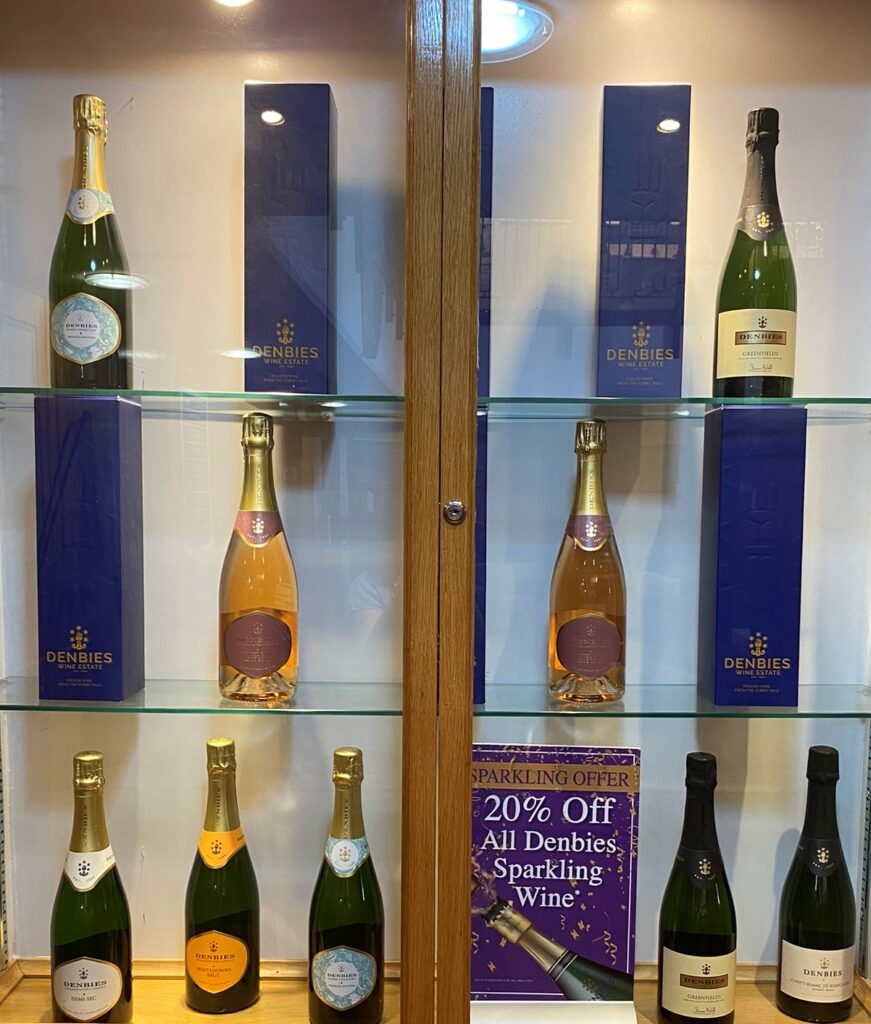Most of the vineyards I’ve visited price their sparkling wine at between £25-35 a bottle. With most Champagnes starting at around £40 you might reasonably wonder why you should therefore pay so much for a bottle of wine that isn’t Champagne! It’s a fair question and here are my thoughts.
The vineyards: France

Only wine made from grapes grown in the Champagne region in North-East France can be labelled Champagne. The grape varieties grown in Champagne are Chardonnay, Pinot Noir and Pinot Meunier and your Champagne will be made with one, or a blend of these.
The vineyards: England

It is only in the last 25 years or so that climate change has made it possible to ripen grapes sufficiently in England to make good sparkling wine. English Sparkling wine may be made in any part of the country – although the South, South-East and South-West regions tend to dominate the market. Grapes permitted are: Chardonnay, Pinot Noir, Pinot Noir Précoce, Pinot Meunier, Pinot Blanc and Pinot Gris.
The winery: France

There are 5 core methods of making sparkling wine, but for now let’s focus on the Traditional Method which is the way that all Champagne must be made.
- Grapes are harvested when just ripe to retain a high level of acidity and low sugar levels. Whole bunches are picked by hand to reduce the risk of damage or oxidation.
- Grapes are pressed gently to extract as pure a juice as possible.
- The juice is fermented, usually in stainless steel tanks, to give a dry, neutral low alcoholic wine. The wine may be blended with other stock from the vineyard to achieve the right style (this Champagne will be labelled NV or Non-Vintage).
- The wine is bottled and to this is added liqueur de tirage (a mixture of a little wine, sugar and yeast). The bottle is closed with a crown cap and laid down – the yeast starts a second fermentation in the bottle which raises the alcohol level of the wine. Carbon dioxide is produced from the fermentation and trapped in the bottle.
- Once the process finishes, the yeast dies leaving a sediment in the bottle – this sounds yucky, but as the wine matures these dead yeast cells break down giving the lovely toasty, biscuity flavours that are characteristic of Champagne! Although the yeast cells help to make the wine taste good, they don’t look so great – no-one wants a cloudy Champagne, so the next process is riddling.
- As the wine matures (for a minimum of 15 months for an NV champagne) the bottles are gradually moved from a horizontal to an inverted vertical position. This used to be done by hand – but is generally now performed by a machine called a gyropalette.
- Once this is complete and the sediment has settled in the neck of the bottles, they are dunked into a freezing solution of brine. A disgorgement machine is then used to remove the crown cap and the pressure in the bottle causes the frozen sediment to be forcibly ejected.
- As the wine has lost a little volume, it is now topped up with liqueur d’expedition – a mixture of wine and sugar – before having a cork added. This whole process takes only a few seconds ensuring the wine retains its bubbles! The quantity of sugar added will determine the type of the final Champagne, e.g. Brut/dry.
- The wine may then continue to be aged prior to sale.
The winery: England

If your English Sparkling Wine is labelled Traditional Method then it will have undergone exactly the same process as described above!
The cost: France

The process to make a wine by the Traditional Method is long, complex and labour intensive – plus land in the Champagne region is expensive. That is why it is impossible to make this magical sparkling liquid under a certain price point.
The cost: England

As we’ve discovered, the same long, labour-intensive process applies – plus as many of the English vineyards are in a very early stage of development, they may have limited stock from previous years to blend when vintages are poor. English Sparkling wine, while receiving international acclaim in tastings and competitions, is still not widely known or experienced outside of the UK.
Summary
If you love Champagne as I do, I encourage you to give English Sparkling Wine a try. Many of the growers and winemakers are creating exciting wines for us to try – made the same way as Champagne with all the balance, finesse and complexity the Traditional Method brings, combined with new, fresh aromas from the English countryside.
It is only with our support and feedback that these vineyards will continue to thrive – so next time you’re planning a celebration, please consider an English Sparkling Wine and wow your guests with your new-found knowledge!


Personally I disagree. Some crémant are truly amazing and follow the same classic method for a fraction of the price. For the UK sparkling to be competitive should be priced around £15. Until then I will drink Champagne or Cremant.
Great point Marco! There are some fabulous crémant wines that are very good value. Do you have a favourite?